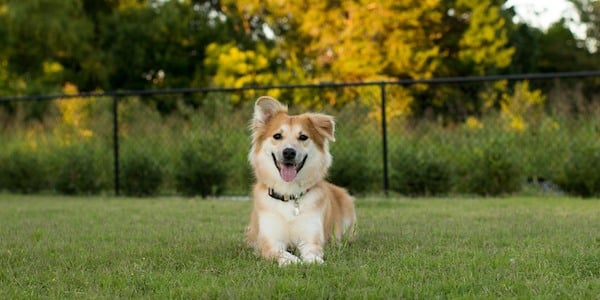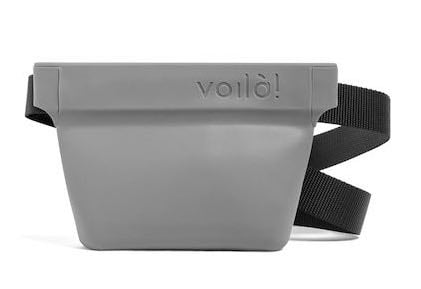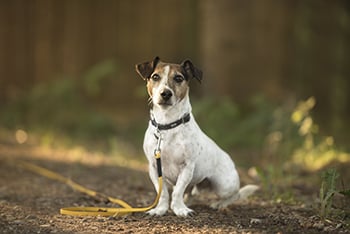 Teaching your dog how to stay is essential for their safety and your peace of mind — it's one of our Top 6 Important Behavior Skills to Train to Keep Your Dog Safe.
Teaching your dog how to stay is essential for their safety and your peace of mind — it's one of our Top 6 Important Behavior Skills to Train to Keep Your Dog Safe.
Stay is quite useful in lots of different situations, from being able to look both ways before crossing a street while out on a walk, to preventing door dashing when you have guests over.
It's also a wonderful cue to practice your dog's self-control and, in some cases, can encourage calm and relaxation. Let's first look at what stay means from a dog training perspective before jumping into the how-to of training your dog to stay.
Define Your Stay Criteria
When you ask your dog to stay it's important that you — and your dog — know exactly what that means. The general definition of stay in dog training is that a dog will hold a stationary position (most commonly the sit, down, or stand position) until they are asked to do something else or given permission to move about with a release word like "okay" or "all done." This means that you're simply extending the length of their Sit, Down, or Stand training cue.
If you plan on competing in Rally-O or Obedience with your dog, the expectations for their stay will be more stringent (no fidgeting from the dog, you're at a further distance from the dog, and a longer length of time in position) than if you're simply training your family dog to hang out on their bed while you greet a guest at the front door. If you have a goal for your dog's ideal stay, it will be easier for you to gauge progress and adjust your training pace.
Think about what your criteria will be for the Duration, Distance, and Distraction level for your dog's stay cue:
- What position will I usually be asking my dog to stay in? Sit, Down, or Stand?
Pro Tip: Often dogs are able to hold a longer duration of stay in a relaxed down position. - How long will I typically need my dog to stay in that position? Long enough to grab their leash before I let them out of the car (about ten seconds) or while you eat dinner with the family (about 30 minutes)?
- How far away will I be from my dog when they are holding their stay? Simply walking to the front door and back? Or will you be going out of your dog's sight?
- Where will I usually be asking my dog to stay? At home where there are few distractions? Or while sitting at the corner cafe with people and other dogs passing by?

Implied Stay versus a Cued Stay
When I start working with a client and their dog on the stay cue, my first question is "Do you want to have to say 'stay' or would you prefer not to have to say anything to have this behavior happen?"
There is no wrong answer to this question, it's simply a matter of preference. I personally prefer what's called an Implied Stay, meaning that if I ask my dog to perform a stationary behavior (whether Sit, Down, or Stand), she will move into that position and hold it until I ask her for something else or tell her she's all done. The stay is implied in the first cue.
A Cued Stay is where the dog has a hand signal or a verbal cue that means "hold this position," separate from the hand signal or verbal cue for sit, down or stand. Some dog owners prefer to give a separate stay cue because of habit or they like the reminder for the dog and themselves. The one downside to relying on a separate cue for stay is that if you forget to give the hand signal or say the word "stay," and your dog moves before they are supposed to, they didn't make any mistake. If you're planning on using a stay cue, make sure you remember to use it during training and later on in real-life scenarios.
How To Train Your Dog to Stay
What You'll Need:
- A dog who has a basic understanding of Sit, Down, or Stand behavior on verbal cue
- A long training leash for when you practice outside of your home or securely fenced area

- A training treat pouch. My favorite, and the one I use the most, is the Voilà Ultimate Treat Pouch. It's high-grade silicone, which makes it easy to wash and perfect for the fresh high-value dog treats I use the most. Use code PV10 to get 10% off!
- Your clicker (or marker word like "yes!" if you're not using a clicker)
- Your dog's favorite training treats (like these Zuke's Mini Naturals training treats or low-fat string cheese or turkey hotdogs cut up into tiny pieces.)
Step One: Build Duration of the Behavior
We'll be using the Down behavior in these steps, but you can substitute any stationary behavior to practice Stay with your dog.
I like to practice adding duration to a behavior first, before adding in things like distractions or the distance I walk away from a dog in a stay. Why? It takes time for me to walk ten feet from my dog and return. In order to set my dog up for success, I need to build a solid foundation of duration.
Practice this duration-building exercise standing right next to or in front of your dog in a low-distraction area, such as your living room.
- Give the "Down" verbal cue to your dog.
- If you are using a cued stay, say "Stay." If you are using an implied (silent) stay, no need to say anything.
- Click or say your marker word when they perform the down (when their elbows hit the floor) and drop the treat between their paws so they don't need to get out of position to eat it.
- Click again after one second as long as they don't move out of position, and drop another treat between their paws.
- If they are comfortable in the down position, try to get another two or three clicks in, with a second or two in between each, before moving to the next step. If they look like they're about to get up, go to the next step.
- Release them from their down with their release word (e.g. "All Done" or "Okay!"). You can toss a treat away from them so they have to get up to eat it, which also resets you for the next repetition of Down.
- Repeat this step, slowly increasing the time between clicks
What you're doing in the above steps is slowly increasing the amount of time your dog holds their Down-Stay. In the beginning, we start with only one or two seconds between clicks or before they are released. But as they start to understand that holding the position makes the treat happen, they are able to hold it a little longer, and then a bit more as you build them up.
During your first short training session, you'll be rewarding for one to three-second stays. In the next session, start easy for a few repetitions before increasing the criteria to clicking every five to seven seconds. Build up how long they can hold their stay between clicking and/or releasing.
To see fast progression in the length of time your dog can hold their stay, keep the environment as distraction-free as possible and stay close to your dog. I like to work up to about 45 seconds to one minute of duration before increasing the criteria by adding in distance.

Step Two: Add in Distance From Your Dog
Once your dog is able to hold their position for longer periods of time, start to increase the distance between you and them as they practice Stay.
Practice this distance-building training exercise in a low-distraction area, such as your living room or a long hallway. The best way to approach adding distance during Stay is to work in small steps. Don't expect your dog to hold their Down-Stay while you walk ten feet away the first time you do this. Think about how you can slice that distance down into manageable pieces and build up your dog.
- Give the "Down" verbal cue to your dog.
- If you are using a verbally cued stay, say "Stay." If you are using an implied (silent) stay, no need to say anything.
- Click when they perform the down (when their elbows hit the floor) and drop the treat between their paws so they don't need to get out of position to eat it.
- Take one step backwards (or turn sideways).
- If they don't move, click and drop a treat between their paws.
- Take one step (or maybe two steps this time if your dog is looking comfortable), or turn a bit more away from your dog.
- Click and treat if they don't move from their stay position.
- Release them from their down with their release word (e.g. "All Done" or "Okay!"). You can toss a treat away from them so they have to get up to eat it, which also resets you for the next repetition of Down.
- Repeat this step, slowly increasing the distance you add before clicking or releasing.
- Mix up how you walk away from your dog. Turn to the right before taking steps away, then turn to the left. Break eye contact so your dog doesn't rely on your continued (and loving) gaze to stay in position, and practice turning your back.
Pro Tip: It's ideal to give the dog their treat reward when they are in the position being rewarded. This can be hard to do if you are further away and don't have the best treat-tossing aim. Fortunately, clickers do give you a small amount of time that acts as a bridge between when you click and when the treat is delivered. You don't want this to be too long, but it's okay if you click when you're five steps away and then walk back immediately to give your dog the treat.
Another option is to walk the distance away and then return, clicking when you get near your dog so you can drop the treat in the right location. You also can use your release cue ("All Done" or "Okay!") to release your dog instead of clicking, tossing the treat anywhere for them to get. Mix up which technique you're using to build a strong Stay at a distance.

Step Three: Add in Distraction to Your Dog's Stay Cue
Now that you've gotten your dog used to holding their Stay for a longer period of time and while you've walked a distance away, it's time to start to generalize this behavior to "proof" it against distractions.
In this step, you'll start to practice Stay in different environments. If you've been practicing inside your home, think about what is an easy step up distraction-wise — this might just be a different room of the house or in your fenced backyard. Lower your criteria for the distance and duration of your dog's Stay when introducing distraction to set you and your dog up for success.
For example, your dog might be able to hold their Down-Stay for 20 seconds while you walk into the kitchen 10 feet away, but when you practice outside with all the sights, sounds, and smells of the great big world, start with a 3 to 5 second Stay with no distance added. Then build up from there!
With repetition and consistency, your dog will be able to hold their Stay for longer, at further distances, and in a variety of places.
Change up where you practice your dog's Stay as they get better and better, always taking into account to lower the duration, distance, or both if distractions are high. My favorite place to practice my dog's Stay around distractions is sitting outside a local coffee shop. I just throw down a small bath mat for her next to my chair, sip my coffee, and toss a treat or release her from her Stay intermittently.
Safety First! If you're practicing Stay with your dog outdoors, do so in a securely fenced area or use a long training lead. You'll want to be confident in your dog's ability to Stay when asked around different distractions (... squirrel! ...) and has a solid recall before letting your dog off leash.
Read these 6 Tips for Taking Your Dog Off Leash to learn how to take your dog off leash safely.
Remember Your 3 D's: Duration, Distance & Distraction
As you start to combine the duration of your dog's stay with distance and distraction, be aware of how to manipulate one at a time so that your dog can be successful. Think of these 3 D's as different knobs on a stereo's audio mixer that you're adjusting to get the right sound. You might turn down the bass to hear the treble more clearly, just as you would turn down the distance to get a better duration in your dog's stay.
When moving from one step to the next, turn down the other D's as much as possible to encourage better performance. Think of yourself as a dog training DJ!
Bonus Tip: There's actually 4 D's! After you've built up duration, distance, and distraction for a behavior, it's time to tackle Delivery of Treats. This means you're ready to fade out food rewards for that specific training cue. To learn how to do this, check out Be a Slot Machine: How to Fade Out Treats in Training.
To see these three D's in action, watch our Facebook Live about Go to Bed and Stay:
Reasons Why Your Dog Can't Hold Their Stay
- You could be expecting too much, too soon. Lower the length of time or the distance you're walking away between clicks, then increase the criteria in small and easy increments.
- Your dog could be distracted! Evaluate your training area to see if there's something that's keeping your dog from focusing on holding position.
- Your dog might be tired. Keep training sessions short and sweet to prevent burnout. Training is lots of brain work — puppies do best with just a few minutes of training at a time, while adult dogs can usually go between 10 to 15 minutes per session.
- Your dog may be stressed. Be careful to evaluate the environment for things that may make your dog uneasy and want to move further away. It's not fair to your dog to make them stay in a position where they feel stressed, fearful, or anxious. Add distance and connect with a certified behavior consultant to help your dog feel more comfortable in those situations.
- Is your dog motivated enough by your rewards? Sometimes a dog is simply not interested in what you're offering. You can substitute treats for toys if your dog finds those more valuable (or is simply not very hungry at the time).
- Are you using a reward that's hard for your dog to stay still for? Be aware that using toys and play as a reward when working on Stay sometimes makes it harder to achieve a higher number of repetitions per session, but does build up your dog's impulse control!
Let us know if you have any questions about teaching your dog to stay in the comments below!




